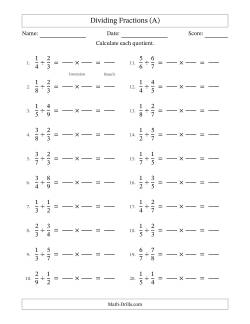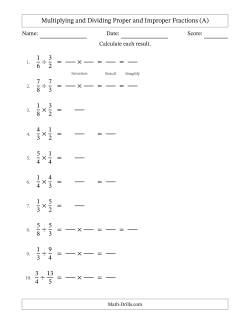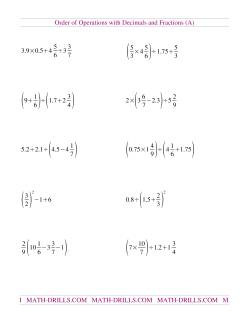Fraction Addition With Easy to Find Common Denominators Math Drills
Welcome to the fractions worksheets page at Math-Drills.com where the cup is half full! This is one of our more popular pages most likely because learning fractions is incredibly important in a person's life and it is a math topic that many approach with trepidation due to its bad rap over the years. Fractions really aren't that difficult to master especially with the support of our wide selection of worksheets.
This page includes Fractions worksheets for understanding fractions including modeling, comparing, ordering, simplifying and converting fractions and operations with fractions. We start you off with the obvious: modeling fractions. It is a great idea if students can actually understand what a fraction is, so please do spend some time with the modeling aspect. Relating modeling to real life helps a great deal too as it is much easier to relate to half a cookie than to half a square. Ask most students what you get if you add half a cookie and another half a cookie, and they'll probably let you know that it makes one delicious snack.
The other fractions worksheets on this page are devoted to helping students understand the concept of fractions. From comparing and ordering to simplifying and converting... by the time students master the material on this page, operations of fractions will be a walk in the park.
Most Popular Fractions Worksheets this Week
General Use Fractions Printables
Fraction Circles

Fraction circle manipulatives are mainly used for comparing fractions, but they can be used for a variety of other purposes such as representing and identifying fractions, adding and subtracting fractions, and as probability spinners. There are a variety of options depending on your purpose. Fraction circles come in small and large versions, labeled and unlabeled versions and in three different color schemes: black and white, color, and light gray. The color scheme matches the fraction strips and use colors that are meant to show good contrast among themselves. Do note that there is a significant prevalence of color-blindness in the population, so don't rely on all students being able to differentiate the colors.
Suggested activity for comparing fractions: Photocopy the black and white version onto an overhead projection slide and another copy onto a piece of paper. Alternatively, you can use two pieces of paper and hold them up to the light for this activity. Use a pencil to represent the first fraction on the paper copy. Use a non-permanent overhead pen to represent the second fraction. Lay the slide over the paper and compare the two circles. You should easily be able to tell which is greater or lesser or if the two fractions are equal. Re-use both sheets by erasing the pencil and washing off the marker.
Adding fractions with fraction circles will involve two copies on paper. Cut out the fraction circles and segments of one copy and leave the other copy intact. To add 1/3 + 1/2, for example, place a 1/3 segment and a 1/2 segment into a circle and hold it over various fractions on the intact copy to see what 1/2 + 1/3 is equivalent to. 5/6 or 10/12 should work.
Fraction Strips

Fractions strips are often used for comparing fractions. Students are able to see quite easily the relationships and equivalence between fractions with different denominators. It can be quite useful for students to have two copies: one copy cut into strips and the other copy kept intact. They can then use the cut-out strips on the intact page to individually compare fractions. For example, they can use the halves strip to see what other fractions are equivalent to one-half. This can also be accomplished with a straight edge such as a ruler without cutting out any strips. Pairs or groups of strips can also be compared side-by-side if they are cut out. Addition and subtraction (etc.) are also possibilities; for example, adding a one-quarter and one-third can be accomplished by shifting the thirds strip so that it starts at the end of one-quarter then finding a strip that matches the end of the one-third mark (7/12 should do it).
Teachers might consider copying the fraction strips onto overhead projection acetates for whole class or group activities. Acetate versions are also useful as a hands-on manipulative for students in conjunction with an uncut page.
The "Smart" Fraction Strips include strips in a more useful order, eliminate the 7ths and 11ths strips as they don't have any equivalents and include 15ths and 16ths. The colors are consistent with the classic versions, so the two sets can be combined.
Modeling Fractions Worksheets
Besides using the worksheets below, you can also try some more interesting ways of modeling fractions. Healthy snacks can make great models for fractions. Can you cut a cucumber into thirds? A tomato into quarters? Can you make two-thirds of the grapes red and one-third green?
Modeling fractions with groups of shapes

Fractions can represent parts of a group or parts of a whole. In these worksheets, fractions are modeled as parts of a group.
Modeling fractions with rectangles

Modeling fractions with circles

Ratio and Proportion Worksheets
Picture ratios

Equivalent fractions

The equivalent fractions models worksheets include only the "baking fractions" in the A versions. To see more difficult and varied fractions, please choose the B to J versions after loading the A version.
Equivalent ratios

Comparing & Ordering Fractions Worksheets
Comparing simple fractions

There are many different strategies other than staring at the page that will help in comparing fractions. Try starting with something visual that will depict the fractions in question. We highly recommend our fraction strips (scroll up a bit). Using a straight edge like a ruler or book or folding will help students to easily see which fraction is greater or if they are equal. We should also mention that the things that are compared should be the same. Each fraction strip for example is the same size whereas if you took a third of a watermelon and half of a grape, the watermelon would probably win out.
Comparing Simple and Improper Fractions

Another strategy to use when comparing fractions is to use a number line and to use benchmarks like 0, 1, 1/2 to figure out where each fraction goes then see which one is bigger. Students actually do this one all the time since they can often compare fractions by recognizing that one is less than half and the other is greater than half. They might also see that one fraction is much closer to a whole than another fraction even though they might both be greater than a half.
Comparing Simple, Improper and Mixed Fractions

Another strategy for comparing fractions is to convert each fraction to a decimal and compare the decimals. Decimal conversions can be memorized (especially for the common fractions) calculated with long division or using a calculator or look-up table. We suggest the latter since using a look-up table often leads to mental recall.
Ordering fractions on a Number Line

Many of the same strategies that work for comparing fractions also work for ordering fractions. Using manipulatives such as fraction strips, using number lines, or finding decimal equivalents will all have your student(s) putting fractions in the correct order in no time. We've probably said this before, but make sure that you emphasize that when comparing or ordering fractions, students understand that the whole needs to be the same. Comparing half the population of Canada with a third of the population of the United States won't cut it. Try using some visuals to reinforce this important concept. Even though we've included number lines below, feel free to use your own strategies.
Ordering fractions

The ordering fractions worksheets in this section do not include a number line, to allow for students to use various sorting strategies.
Simplifying & Converting Fractions Worksheets
Rounding fractions

Rounding fractions helps students to understand fractions a little better and can be applied to estimating answers to fractions questions. For example, if one had to estimate 1 4/7 × 6, they could probably say the answer was about 9 since 1 4/7 is about 1 1/2 and 1 1/2 × 6 is 9.
Simplifying fractions

Learning how to simplify fractions makes a student's life much easier later on when learning operations with fractions. It also helps them to learn that different-looking fractions can be equivalent. One way of demonstrating this is to divide out two equivalent fractions. For example 3/2 and 6/4 both result in a quotient of 1.5 when divided. By practicing simplifying fractions, students will hopefully recognize unsimplified fractions when they start adding, subtracting, multiplying and dividing with fractions.
Converting between improper and mixed fractions

Converting between fractions, decimals, percents, and ratios

Converting Fractions to Terminating Decimals Converting Fractions to Terminating and Repeating Decimals Converting Terminating Decimals to Fractions Converting Terminating and Repeating Decimals to Fractions Converting Fractions to Hundredths Converting Fractions to Decimals, Percents and Part-to-Part Ratios (Terminating Decimals Only) Converting Fractions to Decimals, Percents and Part-to-Whole Ratios (Terminating Decimals Only) Converting Decimals to Fractions, Percents and Part-to-Part Ratios (Terminating Decimals Only) Converting Decimals to Fractions, Percents and Part-to-Whole Ratios (Terminating Decimals Only) Converting Percents to Fractions, Decimals and Part-to-Part Ratios (Terminating Decimals Only) Converting Percents to Fractions, Decimals and Part-to-Whole Ratios (Terminating Decimals Only) Converting Part-to-Part Ratios to Fractions, Decimals and Percents (Terminating Decimals Only) Converting Part-to-Whole Ratios to Fractions, Decimals and Percents (Terminating Decimals Only) Converting Various Fractions, Decimals, Percents and Part-to-Part Ratios (Terminating Decimals Only) Converting Various Fractions, Decimals, Percents and Part-to-Whole Ratios (Terminating Decimals Only) Converting Fractions to Decimals, Percents and Part-to-Part Ratios Converting Fractions to Decimals, Percents and Part-to-Whole Ratios Converting Decimals to Fractions, Percents and Part-to-Part Ratios Converting Decimals to Fractions, Percents and Part-to-Whole Ratios Converting Percents to Fractions, Decimals and Part-to-Part Ratios Converting Percents to Fractions, Decimals and Part-to-Whole Ratios Converting Part-to-Part Ratios to Fractions, Decimals and Percents Converting Part-to-Whole Ratios to Fractions, Decimals and Percents Converting Various Fractions, Decimals, Percents and Part-to-Part Ratios Converting Various Fractions, Decimals, Percents and Part-to-Whole Ratios Converting Various Fractions, Decimals, Percents and Part-to-Part Ratios with 7ths and 11ths Converting Various Fractions, Decimals, Percents and Part-to-Whole Ratios with 7ths and 11ths
Operations with Fractions Worksheets
Dividing Fractions

Conceptually, dividing fractions is probably the most difficult of all the operations, but we're going to help you out. The algorithm for dividing fractions is just like multiplying fractions, but you find the inverse of the second fraction or you cross-multiply. This gets you the right answer which is extremely important especially if you're building a bridge. We told you how to conceptualize fraction multiplication, but how does it work with division? Easy! You just need to learn the magic phrase: "How many ____'s are there in ______? For example, in the question 6 ÷ 1/2, you would ask, "How many halves are there in 6?" It becomes a little more difficult when both numbers are fractions, but it isn't a giant leap to figure it out. 1/2 ÷ 1/4 is a fairly easy example, especially if you think in terms of U.S. or Canadian coins. How many quarters are there in a half dollar?
Adding Fractions

Adding fractions requires the annoying common denominator. Make it easy on your students by first teaching the concepts of equivalent fractions and least common multiples. Once students are familiar with those two concepts, the idea of finding fractions with common denominators for adding becomes that much easier. Spending time on modeling fractions will also help students to understand fractions addition. Relating fractions to familiar examples will certainly help. For example, if you add a 1/2 banana and a 1/2 banana, you get a whole banana. What happens if you add a 1/2 banana and 3/4 of another banana?
Adding Mixed Fractions Worksheets

A common strategy to use when adding mixed fractions is to convert the mixed fractions to improper fractions, complete the addition, then switch back. Another strategy which requires a little less brainpower is to look at the whole numbers and fractions separately. Add the whole numbers first. Add the fractions second. If the resulting fraction is improper, then it needs to be converted to a mixed number. The whole number portion can be added to the original whole number portion.
Subtracting Fractions

There isn't a lot of difference between adding and subtracting fractions. Both require a common denominator which requires some prerequisite knowledge. The only difference is the second and subsequent numerators are subtracted from the first one. There is a danger that you might end up with a negative number when subtracting fractions, so students might need to learn what is means in that case. When it comes to any concept in fractions, it is always a good idea to relate it to a familiar or easy-to-understand situation. For example, 7/8 - 3/4 = 1/8 could be given meaning in the context of a race. The first runner was 7/8 around the track when the second runner was 3/4 around the track. How far ahead was the first runner? (1/8 of the track).
Subtracting Mixed Fractions Worksheets

Various Operations Fractions Worksheets
Mixing up the signs on operations with fractions worksheets makes students pay more attention to what they are doing and allows for a good test of their skills in more than one operation.
Adding and subtracting fractions

Multiplying and dividing fractions

Mixed operations with fractions

Operations with Negative fractions

Although some of these worksheets are single operations, it should be helpful to have all of these in the same location. There are some special considerations when completing operations with negative fractions. It is usually very helpful to change any mixed numbers to an improper fraction before proceeding. It is important to pay attention to the signs and know the rules for multiplying positives and negatives (++ = +, +- = -, -+ = - and -- = +).
Order of Operations with Fractions Worksheets
Order of Operations with Fractions

The order of operations worksheets in this section actually reside on the Order of Operations page, but they are included here for your convenience..
Order of operations with decimals & fractions mixed

Source: https://www.math-drills.com/fractions.php
0 Response to "Fraction Addition With Easy to Find Common Denominators Math Drills"
Post a Comment